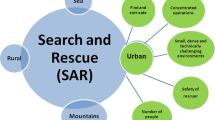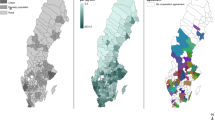Abstract
Geographical accessibility is fundamental when planning rescue services. At present there are several programs for computing the accessibility of stationary rescue units. This study suggests a method for evaluating geographic accessibility in scenarios containing also non-stationary units. The method supports the planning process by matching the risk of an incident occurring with the rescue units’ capabilities and accessibility. The method is implemented in the computer program Rescue Unit Planner. The result of the analysis is presented in thematic maps and graphs as level of coverage, mean response time and concentration. The method and the computer program have been evaluated in two case studies: one urban area in southern Sweden and one rural area in northern Sweden. The case studies show that that this method can be useful in the rescue service planning process.











Similar content being viewed by others
References
Jadell H (2004) Tidsfaktorns betydelse vid räddningsinsatser. Rescue Services Agency
Savas ES (1969) Simulation and cost-effectiveness analysis of New York’s emergency ambulance service. Manage Sci v15:B608–B627
Larson RC (1975) Approximating the performance of urban emergency service systems. Oper Res 23(5):845–868
Stout J (1983) System status management: the strategy of ambulance placement. JEMS 9(5):22–32
Guagliardo MF (2004) Spatial accessibility of primary care: concepts, methods and challenge. Int J Health Geogr 3(3)
Berglund S (2001) GIS in transport modelling. Doctoral thesis. Department of Infrastructure and Planning, Royal Institute of Technology, Sweden
Bergqvist R, Tornberg J (2005) GIS for describing and analysing regional logistics systems. Mapp Image Sci 2:61–68
Eurosys, Eurosys AB, http://www.eurosys.se (2007-11-08)
Effektanalys 1.0 - User manual, The rescue service in Jönköping, 2005
FSEC (Fire Service Emergency Cover) http://www.communities.gov.uk/fire/runningfire/fireserviceemergency/
ADAM (Deccan International) http://www.deccanintl.com/adam_overview.asp
Kolesar P, Blum E (1973) Square root law for fire engine response distances. Manage Sci 19(12):1368–1378
Hogg J (1968) The siting of fire stations. Oper Res Q 19(3):275–287
Toregas C, Swain R, ReVelle C, Bergman L (1971) The location of emergency service facilities. Oper Res 19(6):1363–1373
Karasakal O, Karasakal E (2004) A maximal covering location model in the presence of partial coverage. Comput Oper Res 31:1515–1526
Andersson T, Värbrand P (2007) Decision support tools for ambulance dispatch and relocation. J Oper Res Soc 58(2):195–201
Kolesar P, Walker W (1974) An algorithm for the dynamic relocation of fire companies. Oper Res 22(2):249–274
Swersey AJ (1982) A Markovian decision model for deciding how many fire companies to dispatch. Manage Sci 28(4):352–365
Huang B, Pan X (2007) GIS coupled with traffic simulation and optimization for incident response. Comput Environ Urban Syst 31:116–132
Andersson T, Särdqvist S (2007) Planning for effective use of fire and rescue service resources. Manuscript
Svensson S, Särdqvist S (2006) Grundmodell inom ramarna för BeRädd. Swedish Rescue Services Agency
Handy SL, Niemer DA (1997) Measuring accessibility: an exploration of issues and alternatives. Environ Plann A 29:1175–1194
MapInfo (2007) MapXtreme. www.mapinfo.com
Dahlgren A (2005) A proximity analysis application for large source dataset. In Proceedings of ScanGIS 2005, Stockholm, pp 125–136
Dahlgren A, Harrie L (2007) Development of a tool for proximity applications. In Proceedings of Agile 2007, Ålborg, Denmark
Swedish National Rural Development Agency (2007) http://www.glesbygdsverket.se
Danielsson J (2007) Analytisk dimensionering av räddningstjänst. Department of Fire Safety Engineering and Systems Safety, Lund University, Report 5243
Adawi R, Olsson P, Pettersson M, Wahl P (2007) Utformning av arbete Skydd mot olyckor i Kävlinge kommun
Dahlgren A (2007) PM Försöksområde Vemdalen - utvärdering av geografisk tillgänglighet av räddningstjänsten. Glesbygdsverket
Muncipality of Berg (2007) Overview plan of the Vemdalen-Björnrike area
Muncipality of Härjedalen (2007) Overview plan of the Storhogna-Sångbäcken-Katarina area
Acknowledgements
This study is part of the Geographic Accessibility Studies project. Financial support from the Swedish Rescue Services and Swedish National Rural Development Agency is acknowledged. Thanks to the rescue services in Malmö, Berg and Härjedalen for their cooperation on the case studies. We would especially like to thank Johan Danielsson, Rima Adawi, Sven-Erik Svensson (rescue services in Berg Municipality) and Kurt Svensson (rescue services in Härjedalen Municipality). We are also thankful to Tobias Andersson (Linköping University), Anders Östman (University of Gävle) and Martin Palm for valuable comments.
Author information
Authors and Affiliations
Corresponding author
Rights and permissions
About this article
Cite this article
Dahlgren, A., Harrie, L. & Axelsson, A. Planning Rescue Services with Non-Stationary Rescue Units. Fire Technol 45, 239–255 (2009). https://doi.org/10.1007/s10694-008-0051-y
Received:
Accepted:
Published:
Issue Date:
DOI: https://doi.org/10.1007/s10694-008-0051-y




